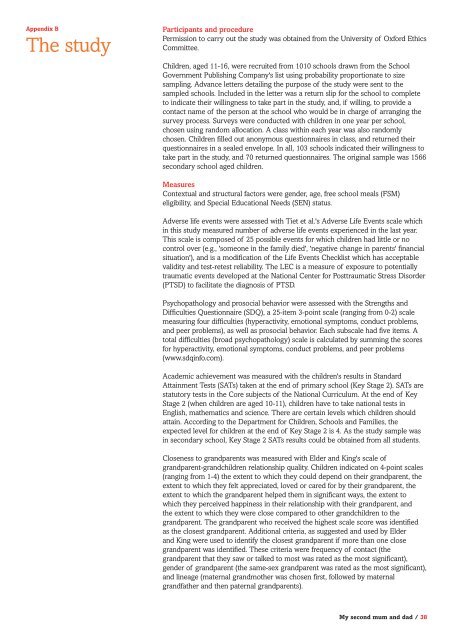“My second mum and dad” - Grandparents Plus
“My second mum and dad” - Grandparents Plus
“My second mum and dad” - Grandparents Plus
Create successful ePaper yourself
Turn your PDF publications into a flip-book with our unique Google optimized e-Paper software.
Appendix B<br />
The study<br />
Participants <strong>and</strong> procedure<br />
Permission to carry out the study was obtained from the University of Oxford Ethics<br />
Committee.<br />
Children, aged 11-16, were recruited from 1010 schools drawn from the School<br />
Government Publishing Company's list using probability proportionate to size<br />
sampling. Advance letters detailing the purpose of the study were sent to the<br />
sampled schools. Included in the letter was a return slip for the school to complete<br />
to indicate their willingness to take part in the study, <strong>and</strong>, if willing, to provide a<br />
contact name of the person at the school who would be in charge of arranging the<br />
survey process. Surveys were conducted with children in one year per school,<br />
chosen using r<strong>and</strong>om allocation. A class within each year was also r<strong>and</strong>omly<br />
chosen. Children filled out anonymous questionnaires in class, <strong>and</strong> returned their<br />
questionnaires in a sealed envelope. In all, 103 schools indicated their willingness to<br />
take part in the study, <strong>and</strong> 70 returned questionnaires. The original sample was 1566<br />
<strong>second</strong>ary school aged children.<br />
Measures<br />
Contextual <strong>and</strong> structural factors were gender, age, free school meals (FSM)<br />
eligibility, <strong>and</strong> Special Educational Needs (SEN) status.<br />
Adverse life events were assessed with Tiet et al.'s Adverse Life Events scale which<br />
in this study measured number of adverse life events experienced in the last year.<br />
This scale is composed of 25 possible events for which children had little or no<br />
control over (e.g., 'someone in the family died', 'negative change in parents' financial<br />
situation'), <strong>and</strong> is a modification of the Life Events Checklist which has acceptable<br />
validity <strong>and</strong> test-retest reliability. The LEC is a measure of exposure to potentially<br />
traumatic events developed at the National Center for Posttraumatic Stress Disorder<br />
(PTSD) to facilitate the diagnosis of PTSD.<br />
Psychopathology <strong>and</strong> prosocial behavior were assessed with the Strengths <strong>and</strong><br />
Difficulties Questionnaire (SDQ), a 25-item 3-point scale (ranging from 0-2) scale<br />
measuring four difficulties (hyperactivity, emotional symptoms, conduct problems,<br />
<strong>and</strong> peer problems), as well as prosocial behavior. Each subscale had five items. A<br />
total difficulties (broad psychopathology) scale is calculated by summing the scores<br />
for hyperactivity, emotional symptoms, conduct problems, <strong>and</strong> peer problems<br />
(www.sdqinfo.com).<br />
Academic achievement was measured with the children's results in St<strong>and</strong>ard<br />
Attainment Tests (SATs) taken at the end of primary school (Key Stage 2). SATs are<br />
statutory tests in the Core subjects of the National Curriculum. At the end of Key<br />
Stage 2 (when children are aged 10-11), children have to take national tests in<br />
English, mathematics <strong>and</strong> science. There are certain levels which children should<br />
attain. According to the Department for Children, Schools <strong>and</strong> Families, the<br />
expected level for children at the end of Key Stage 2 is 4. As the study sample was<br />
in <strong>second</strong>ary school, Key Stage 2 SATs results could be obtained from all students.<br />
Closeness to gr<strong>and</strong>parents was measured with Elder <strong>and</strong> King's scale of<br />
gr<strong>and</strong>parent-gr<strong>and</strong>children relationship quality. Children indicated on 4-point scales<br />
(ranging from 1-4) the extent to which they could depend on their gr<strong>and</strong>parent, the<br />
extent to which they felt appreciated, loved or cared for by their gr<strong>and</strong>parent, the<br />
extent to which the gr<strong>and</strong>parent helped them in significant ways, the extent to<br />
which they perceived happiness in their relationship with their gr<strong>and</strong>parent, <strong>and</strong><br />
the extent to which they were close compared to other gr<strong>and</strong>children to the<br />
gr<strong>and</strong>parent. The gr<strong>and</strong>parent who received the highest scale score was identified<br />
as the closest gr<strong>and</strong>parent. Additional criteria, as suggested <strong>and</strong> used by Elder<br />
<strong>and</strong> King were used to identify the closest gr<strong>and</strong>parent if more than one close<br />
gr<strong>and</strong>parent was identified. These criteria were frequency of contact (the<br />
gr<strong>and</strong>parent that they saw or talked to most was rated as the most significant),<br />
gender of gr<strong>and</strong>parent (the same-sex gr<strong>and</strong>parent was rated as the most significant),<br />
<strong>and</strong> lineage (maternal gr<strong>and</strong>mother was chosen first, followed by maternal<br />
gr<strong>and</strong>father <strong>and</strong> then paternal gr<strong>and</strong>parents).<br />
My <strong>second</strong> <strong>mum</strong> <strong>and</strong> dad / 38


